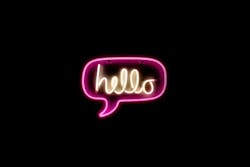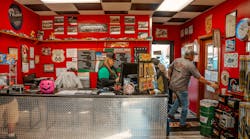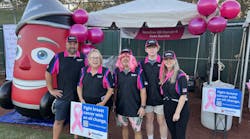SHOP STATS: Turbo Tim's Anything Automotive Location: NE Minneapolis, MN. Owner: Rachel Grewell and Tim Suggs Average Monthly Car Count: 110 Staff Size: 20 Shop Size: 16,000 square feet Annual Revenue: $3 million
For small businesses, the ability to market themselves appropriately and to as large or an audience as possible is essential. Most shops will run advertisements in local media, push their brand hard on social media, or send out mailers, but not too many shops consider merchandise.
Common in other industries, merchandise can be a great way to market a service while also creating a connection between the business and a customer that an advertisement or social post couldn’t.
Through the merchandising of t-shirts and stickers, Turbo Tim’s—a repair shop in Minneapolis, Minn. that does roughly 200 oil changes a month—has been able to cultivate a robust customer base that cares deeply about the success of a shop.
There are so many options to choose from when it comes to merchandise. Hats, t-shirts, sunglasses, pens, keychains, stickers—the list goes on. So how should a shop decide what to choose and what should they keep in mind during the process? National Oil and Lube News discussed those questions with Rachel Grewell, co-owner of Turbo Tim’s, and Erin Shea, the North American market director for the online printing service Vistaprint.
Don’t treat it as a revenue stream.
The making of the Turbo Tim’s t-shirts were never intended to come with a high price tag, Grewell says. Currently selling them for $5, the shop will often give them away for free during community events and through different promotions.
At first the t-shirts were just for employees. But after customers expressed interest in purchasing a shirt, Grewell saw it as an opportunity.
The amount of money the t-shirts generate alone isn’t much. They could charge more for them if they wanted to, Grewell says. But it’s not about maximizing the profit of every t-shirt sale. To Grewell, it’s much more of a marketing and customer retention tool.
“There’s something to be said for return on investment, but when it comes to branding and brand recognition and community participation, it’s hard to put a value on that,” Grewell says.
And the cost doesn’t have to be enormous to purchase merchandise or other promotional items.
“Whether a business is buying in bulk or small quantities across our other product categories, it is easy to impact your business regardless of the size of your budget,” says Shea, adding that the average order is only $55.
By far, Turbo Tim’s most successful merchandise turned marketing campaign is its bumper stickers. Available for free to any customer, the shop will give out a 10 percent discount for anyone that puts a Turbo Tim’s bumper sticker on their car. That discount lasts for the life of the car. So every visit that car makes with the sticker somewhere on it, they’ll receive a discount.
“We’re incredibly grateful when someone is willing to put something on a valuable asset of theirs that has our name on it. So we like to reward those customers.”
National or Local?
—
Deciding where to order merchandise can often be as stressful as what to order. Rachel Grewell, co-owner of Turbo Tim’s in Minneapolis, Minn., has used both local and national companies for the shop’s merchandise. While the t-shirts have always been made local, she began using a national manufacturer for the Turbo Tim’s stickers. She found the stickers were starting to wear with the local provider she was using and they wanted to expand into other types of stickers, like decals. With the expanded need, a larger manufacturer was the way to go.
But Grewell recommends assessing exactly what your business needs. National manufacturers, like Vistaprint, will likely have more resources to buy in bulk which may lead to a greater discount. Local shops have the benefit of being local, giving them a leg up on customer service and the benefit of being very close to the business to work through any concerns or questions.
It creates a community.
It’s not uncommon for customers to tell stories of seeing the Turbo Tim’s bumper sticker in other states, Grewell says. She’s heard of customers that strike up a connection at their own workplace after seeing a co-worker drive in with the bumper sticker on their car. She senses it has helped foster inclusion and connection among those that like the shop. And from there it just continues to spread.
“The number of cars driving around with our bumper sticker is unbelievable, and that’s usually how someone finds out about us,” she says. “Our bumper sticker is the first thing that people mention to us when they walk in. You can’t put a value on that.”
Grewell says she’ll often see customers come in who didn’t know about the shop, but after buying someone’s vehicle that had the sticker, they decide to try it for themselves.
The t-shirts have created a similar effect. Customers routinely wear their Turbo Tim’s shirts when they get their vehicle serviced. It makes them feel a part of the team, Grewell says.
She recalls a story a customer once told her about how her 10th grade son wore his Turbo Tim’s shirt on the first day of school, even after the parents went out and bought him much more expensive clothes to wear back to school.
“It’s a big deal for youth to think you’re cool enough to wear the shirt,” she says.
Make it authentic to the brand.
Don’t just slap on the logo and company name and call it a day. With both the stickers and t-shirts, Grewell has emphasized creativity and uniqueness. Think about what embodies the brand of the shop and go with that. It’s what Grewell believes sets their products apart from a free t-shirt that someone might just toss in the trash. It’s why that student wore the t-shirt to school instead of something else.
“What’s worked for us is to be authentic in who we are,” she says. “If you’re proud to wear the t-shirt and think it’s cool, make it. Don’t come up with something just because you think other people will like it.”
For Turbo Tim’s that has meant artistic and silly designs. That fits the brand of the shop. For others, maybe it’s less about the design and what that design is on. Make a cool pen, or a bottle opener, or a key chain. Whatever it is, make sure it encompasses the brand that the shop promotes, Grewell says.





